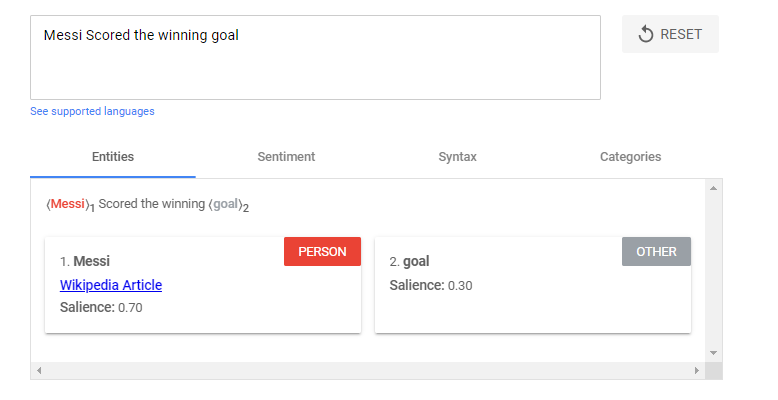Entity salience offers a peek into the way Google’s AI appraises content in order to create an objective score for web pages.
Whenever we type in a search, as humans we can easily decide which piece of content is best suited to our needs. On the other hand, Google has to process 2.4 million searches per minute, while matching them to content across a web whose size is tending towards infinity i.e. The web contains trillions of pages, while Google’s index contains only about 50 billion of these pages. So at the speed of thought, Google has to decide which site offers the best content for multiple queries (15% of these searches are unique)
How on earth does Google manage to do this? How can Google manage to consistently serve good results faster than most websites or mobile apps can load content?
We would never really know, however Google gave us a glimpse through the entity salience scores offered in their NLP demo. In this article I will attempt to guide SEO content writers on entity salience as a concept and how to optimize articles against this metric.
What is an entity?
An entity is the noun or set of nouns contained in a text. Anything that has a name in your blog or article is therefore an entity. They are nouns and noun phrases that the AI can identify as a distinct object. Google’s entity categories include people, locations, organizations, numbers, consumer goods and more
What is Entity Salience
The noun “salience” derives from the Latin word saliens – ‘leaping, or bounding’. In modern usage it means “Prominent”, “stand out”.
Entity salience therefore refers to the degree of prominence that’s ascribed to a named object within a piece of text.
The salience score for an entity provides information about the importance or centrality of that entity to the entire document. Below is an example
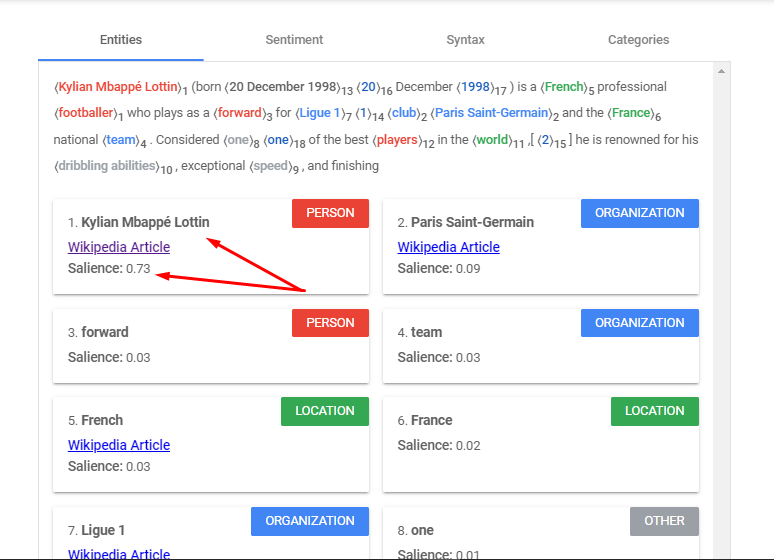
Scores closer to 0 are less salient, while scores closer to 1.0 are highly salient.
How Content Writers Can Optimize for Entity Salience
Since salience scores are more important than simplistic keyword stuffing, every writer needs to know how these scores are calculated in order to produce content that can rank
How The Salience Score Is Calculated
Based on Google research papers, there are certain textual attributes that determine the scores assigned to each named object within a sentence. The factors are;
- The entity’s position in the text
- The entity’s grammatical role
- The entity’s linguistic links to other parts of the sentence
- The clarity of the entity
- Named, nominal and pronominal reference counts of the entity
1. The entity’s position in the text
One of the most basic elements of salience is text position. In general, beginnings are the most prominent positions in a text. Therefore, entities placed closer to the beginning of the text and, to a lesser extent, each paragraph and sentence, are seen as more salient. The end of a sentence is also slightly more prominent than the middle.
Advice To Writers: Position the target keyword towards the start of the text, paragraphs and sentences.
2. The entity’s grammatical role
The grammatical role of the entity is usually contingent on its subject or object relationship with the rest of the text.
The subject (the entity that is doing something) of a sentence is more prominent than the object (the entity to which something is being done).
- Messi Scored the winning goal
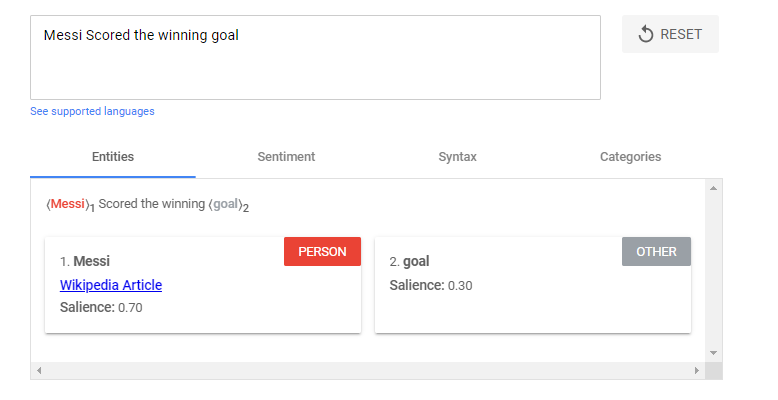
- The winning goal was scored by Messi
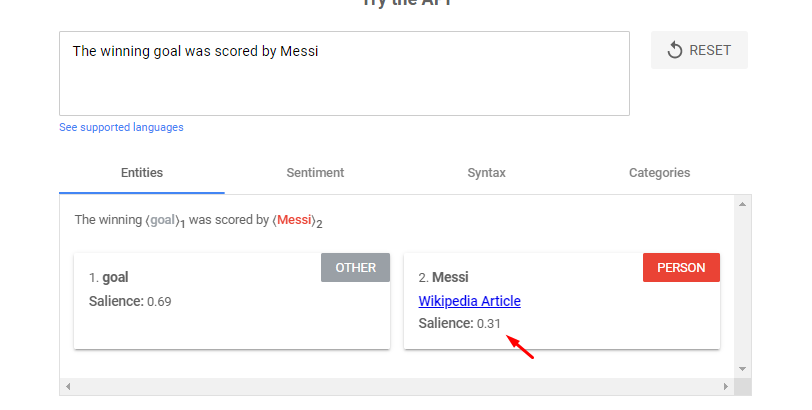
In the first sentence, “Messi” has a score of 0.7, whereas “goal” has a score of 0.3. In the second sentence, “goal” is more salient, with 0.69, whereas “Messi” has a score of 0.31.
Advice to writers: Reword your write ups to ensure that the target keyword is the subject of the sentence wherever possible.
3. The entity’s linguistic links to other parts of the sentence
If you use the Syntax tab in Google’s API demo, you’ll actually see a sentence-by-sentence breakdown of which words link to each other, along with a grammatical label.
I plugged this sample sentence in – “France held Argentina to penalties but could not have done it without Mbappe’s hattrick”
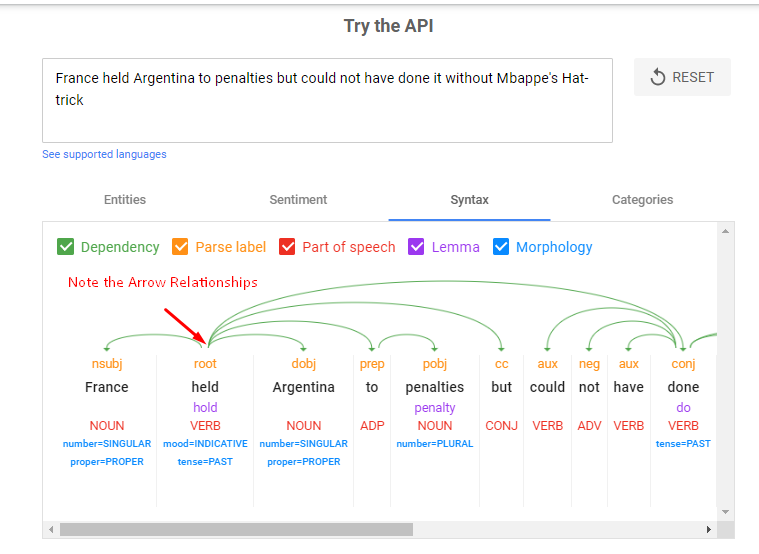
We can see how the entity “France” links to so many parts of the sentence through the verb “Held”.
An Entity does not need to be repeated artificially in every clause for it to be seen as prominent. It is more important that the other clauses and entities in the sentence depend on the target keyword for their meaning. This is how the linguistic dependency factors into the entity salience score
Advice for writers: When using target keywords in longer sentences, structure the sentence so that its clauses and other entities depend on your target keyword for sense.
4. The Entity’s Clarity
Google’s NLP tool is good at recognising entities but it’s not perfect. For example, it’s not great at recognising two entities as the same when their capitalisation, pluralisation or acronym changes.
Writers should also be wary of how switching between acronyms and full phrases (“SEO” vs “search engine optimization”) can impact salience scores
Advice To Writers: Refer to your target keyword consistently throughout the text if it is a multi-word phrase.
5. The Named, Nominal And Pronominal Reference Counts Of The Entity
The frequency with which an entity is mentioned in your text is a straightforward but crucial aspect of salience scoring. However, resist the urge to veer into archaic, spammy writing techniques. Increased mentions of your focus entities shouldn’t ever be used as a cover for keyword stuffing.
Note: Google has the ability to recognise different references to the same thing e.g.
- Mo Salah – named
- Striker – nominal
- He – pronominal
Advice To Writers: Increase mentions of your focus entities by using a mixture of named, nominal and pronominal references, don’t just repeat the named phrase every time it comes up.
Limitations of Google’s NLP Demo Tool
The natural language processing API demo is best used for product pages, short service, category pages, meta descriptions and ad copy. However, for long form content, its usefulness diminishes the longer the text you input. There is no way for it to process all the signals given across multiple sections of text.
Hence for longer pages, you may want to analyze single sections bit by bit rather than at once.
Conclusion
Google’s natural language API demo gives content writers a tool to help them craft their writing in a more structured way. If you are a writer and are looking to improve your SEO skillset, then you should integrate entity salience analytics into your practice.

